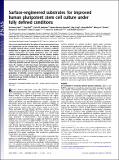| dc.contributor.author | Saha, Krishanu | |
| dc.contributor.author | Mei, Ying | |
| dc.contributor.author | Reisterer, Colin M. | |
| dc.contributor.author | Pyzocha, Neena Kenton | |
| dc.contributor.author | Yang, Jing | |
| dc.contributor.author | Muffat, Julien | |
| dc.contributor.author | Davies, Martyn C. | |
| dc.contributor.author | Alexander, Morgan R. | |
| dc.contributor.author | Jaenisch, Rudolf | |
| dc.contributor.author | Langer, Robert S | |
| dc.contributor.author | Anderson, Daniel Griffith | |
| dc.date.accessioned | 2012-10-18T18:11:09Z | |
| dc.date.available | 2012-10-18T18:11:09Z | |
| dc.date.issued | 2011-11 | |
| dc.date.submitted | 2011-09 | |
| dc.identifier.issn | 0027-8424 | |
| dc.identifier.issn | 1091-6490 | |
| dc.identifier.uri | http://hdl.handle.net/1721.1/74094 | |
| dc.description.abstract | The current gold standard for the culture of human pluripotent stem cells requires the use of a feeder layer of cells. Here, we develop a spatially defined culture system based on UV/ozone radiation modification of typical cell culture plastics to define a favorable surface environment for human pluripotent stem cell culture. Chemical and geometrical optimization of the surfaces enables control of early cell aggregation from fully dissociated cells, as predicted from a numerical model of cell migration, and results in significant increases in cell growth of undifferentiated cells. These chemically defined xeno-free substrates generate more than three times the number of cells than feeder-containing substrates per surface area. Further, reprogramming and typical gene-targeting protocols can be readily performed on these engineered surfaces. These substrates provide an attractive cell culture platform for the production of clinically relevant factor-free reprogrammed cells from patient tissue samples and facilitate the definition of standardized scale-up friendly methods for disease modeling and cell therapeutic applications. | en_US |
| dc.description.sponsorship | Howard Hughes Medical Institute | en_US |
| dc.description.sponsorship | National Institutes of Health (U.S.) (Grant R37-CA084198) | en_US |
| dc.description.sponsorship | National Institutes of Health (U.S.) (Grant RO1 CA087869) | en_US |
| dc.description.sponsorship | National Institutes of Health (U.S.) (Grant RO1 HD045022) | en_US |
| dc.description.sponsorship | National Institutes of Health (U.S.) (Grant DE016516) | en_US |
| dc.description.sponsorship | Wellcome Trust (London, England) (Grant 085246) | en_US |
| dc.language.iso | en_US | |
| dc.publisher | National Academy of Sciences | en_US |
| dc.relation.isversionof | http://dx.doi.org/10.1073/pnas.1114854108 | en_US |
| dc.rights | Article is made available in accordance with the publisher's policy and may be subject to US copyright law. Please refer to the publisher's site for terms of use. | en_US |
| dc.source | PNAS | en_US |
| dc.title | Surface-engineered substrates for improved human pluripotent stem cell culture under fully defined conditions | en_US |
| dc.type | Article | en_US |
| dc.identifier.citation | Saha, K. et al. “Surface-engineered Substrates for Improved Human Pluripotent Stem Cell Culture Under Fully Defined Conditions.” Proceedings of the National Academy of Sciences 108.46 (2011): 18714–18719. Copyright ©2011 by the National Academy of Sciences | en_US |
| dc.contributor.department | Harvard University--MIT Division of Health Sciences and Technology | en_US |
| dc.contributor.department | Massachusetts Institute of Technology. Department of Biology | en_US |
| dc.contributor.department | Massachusetts Institute of Technology. Department of Chemical Engineering | en_US |
| dc.contributor.department | Koch Institute for Integrative Cancer Research at MIT | en_US |
| dc.contributor.mitauthor | Mei, Ying | |
| dc.contributor.mitauthor | Reisterer, Colin M. | |
| dc.contributor.mitauthor | Yang, Jing | |
| dc.contributor.mitauthor | Davies, Martyn C. | |
| dc.contributor.mitauthor | Alexander, Morgan R. | |
| dc.contributor.mitauthor | Langer, Robert | |
| dc.contributor.mitauthor | Anderson, Daniel G. | |
| dc.contributor.mitauthor | Jaenisch, Rudolf | |
| dc.relation.journal | Proceedings of the National Academy of Sciences | en_US |
| dc.eprint.version | Final published version | en_US |
| dc.type.uri | http://purl.org/eprint/type/JournalArticle | en_US |
| eprint.status | http://purl.org/eprint/status/PeerReviewed | en_US |
| dspace.orderedauthors | Saha, K.; Mei, Y.; Reisterer, C. M.; Pyzocha, N. K.; Yang, J.; Muffat, J.; Davies, M. C.; Alexander, M. R.; Langer, R.; Anderson, D. G.; Jaenisch, R. | en |
| dc.identifier.orcid | https://orcid.org/0000-0001-5629-4798 | |
| dc.identifier.orcid | https://orcid.org/0000-0003-4255-0492 | |
| mit.license | PUBLISHER_POLICY | en_US |
| mit.metadata.status | Complete | |
